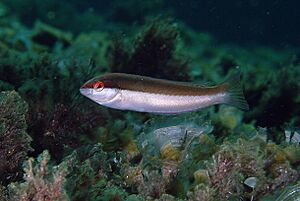Mediterranean rainbow wrasse facts for kids
Quick facts for kids Mediterranean rainbow wrasse |
|
|---|---|
 |
|
| Male in the coast of Cape Palos (Spain) | |
| Conservation status | |
| Scientific classification |
The Mediterranean rainbow wrasse (Coris julis) is a small, colorful fish. It belongs to the Labridae family, which includes many bright and active fish. You can find this fish in the Mediterranean Sea and in the northeast Atlantic Ocean. It lives in waters from Sweden down to Senegal. Sometimes, it even wanders to the southern British Isles. Fish found further south, near Senegal and the Cape Verde Islands, are actually a very similar fish called Coris atlantica.
What Does the Rainbow Wrasse Eat?
This fish enjoys a diet of small sea creatures. These include tiny amphipods and isopods, which are like small crustaceans. It also dines on sea urchins, polychaete worms, shrimps, and small gastropods (snails).
What Does the Rainbow Wrasse Look Like?

Like many wrasses, the Mediterranean rainbow wrasse can change its sex. All young fish start in an "initial phase." These initial-phase fish, both males and females, can later turn into larger "secondary-phase" males. Once a fish reaches about 18 centimeters (about 7 inches) long, it will always be a secondary-phase male. The biggest these fish get is about 25 centimeters (about 10 inches).
There is a big difference in how the two phases look. In the Mediterranean Sea, the secondary-phase male is very colorful. It can be green, blue, or brown, with a white belly. It has a dark blue spot near its bottom fin and a bright orange stripe along its side. The smaller initial-phase females and males are usually brown. They have yellowish sides and white bellies. Fish in the Atlantic Ocean look a bit different in color. They also have different genetics from the Mediterranean fish. However, for now, scientists consider them the same species.
Where Does the Rainbow Wrasse Live?
You can usually find this fish close to the shore. It likes places with seagrass beds or rocky areas. It typically lives in water that is 0 to 60 meters (0 to 197 feet) deep. However, it has been found as deep as 120 meters (394 feet).


